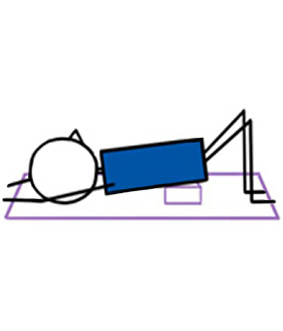
| Category: | Pilates Lesson Planner |
|---|---|
| Sub Category: | Matwork |
| Types: | Restorative, Seated & Floor, Stretch, Supine |
| Anatomy: | Neck |
| Chakras: | Crown Centre, Heart Centre |
| Therapy: | Anxiety, Stress |
| Drishti: | Side |
| Dosha: | Vata |
Start in Side Lying position with a cushion under your head. Bend knees at right angles. Extend arms in front at shoulder height, palms together. Inhale, lift top arm straight above shoulder toward ceiling, rotating head and spine. Exhale, continue spine rotation, lowering arm. Inhale, rotate spine back, lifting arm. Exhale, return to start position.
Improves spinal mobility and shoulder stability. Enhances core engagement and posture alignment.
A) Place a pillow under the head for neck support. B) Bend the bottom arm and rest the head on it. C) Perform the movement with a smaller range of motion.
Click here for lots of FREE downloadable Yoga lesson plans.
Click here for lots of FREE downloadable Pilates lesson plans.
Exploring the Pilates Side Lying Arm Opener: Enhancing Flexibility and Strength
In Pilates, the Side Lying Arm Opener stands out as a versatile exercise that enhances flexibility, strengthens the core, and improves overall body alignment.
This blog post delves deep into the nuances of this Pilates exercise, exploring its benefits, step-by-step techniques, variations, and considerations for practitioners of all levels.
Introduction to Pilates Side Lying Arm Opener
The Pilates Side-Lying Arm Opener promotes spinal mobility, enhances shoulder stability, and effectively engages the core muscles. It is performed in a side-lying position, using controlled movements to stretch and strengthen various muscle groups while emphasising proper alignment and breath awareness.
6 Benefits of Pilates Side Lying Arm Opener
Benefit 1: Spinal Mobility
The exercise promotes flexibility in the spine, particularly in the thoracic region, reducing stiffness and improving overall mobility.
Benefit 2: Shoulder Stability
Extending and rotating the arm enhances shoulder stability and strengthens the muscles surrounding the shoulder joint.
Benefit 3: Core Engagement
During the movement, core muscles stabilise the spine and pelvis, fostering better posture and spinal alignment.
Benefit 4: Postural Alignment
Practising this exercise encourages proper spine, shoulder, and hip alignment, which can alleviate tension and prevent injuries caused by poor posture.
Benefit 5: Mind-Body Connection
It cultivates mindfulness through coordinated breath with movement, enhancing body awareness and promoting relaxation.
Benefit 6: Improved Functional Movement
Regular practice enhances the ability to perform daily activities with greater ease and efficiency by strengthening functional movement patterns.
Step-by-Step Guide to Pilates Side Lying Arm Opener
Follow these steps to perform the Pilates Side Lying Arm Opener effectively:
Step 1: Starting Position
Lie on your side with your legs extended and stacked on each other. Place a cushion or small pillow under your head for support.
Step 2: Arm Position
Extend both arms straight out in front of you at shoulder height, palms together or facing each other.
Step 3: Inhale
As you inhale, lift your top arm straight above your shoulder joint toward the ceiling, keeping it in line with your body.
Step 4: Rotation
Simultaneously rotate your head, neck, and upper spine towards the ceiling, following the movement of your lifted arm.
Step 5: Exhale
As you exhale, continue rotating your spine further, allowing your arm to lower towards the mat in a controlled manner.
Step 6: Inhale
Reverse the movement by initiating the rotation from your centre (core), lifting your arm back above your shoulder joint towards the ceiling.
Step 7: Exhale
Return to the starting position by rotating your spine to the original side-lying position, maintaining control throughout the movement.
3 Modifications for the Pilates Side Lying Arm Opener
Modification 1: Pillow Support
Place a pillow or folded blanket under your head for added comfort and support, especially if you have neck sensitivity.
Modification 2: Arm Placement
If lying directly on your arm is uncomfortable, modify the arm position by bending the bottom arm and resting your head on it.
Modification 3: Range of Motion
Adjust the range of motion by performing smaller movements initially, gradually increasing as your flexibility and strength improve.
4 Tips for Practicing Pilates Side Lying Arm Opener
Tip 1: Mindful Movement
Focus on the quality of movement rather than speed. Pay attention to your body alignment and how each spine segment moves sequentially.
Tip 2: Breath Awareness
Coordinate your breath with each movement. Inhale during the opening phase and exhale during the closing phase to enhance relaxation and core engagement.
Tip 3: Warm-Up
The Side Lying Arm Opener is an ideal warm-up exercise for a Pilates routine.
Tip 4: Standalone Practice
Practice the Side Lying Arm Opener as a quick stretching and strengthening exercise throughout the day, especially if you spend long hours sitting or standing.
3 Precautions
Precaution 1: Neck or Spine Issues
If you have a history of neck or spine injuries or conditions, consult a healthcare professional before attempting this exercise.
Precaution 2: Pregnancy
Modify the exercise by using additional support and avoiding excessive twisting movements if you are pregnant or postpartum.
Precaution 3: Discomfort or Pain
If you experience discomfort or pain, discontinue the exercise and seek guidance from a qualified instructor or healthcare provider.




 Yoga Lesson Planner
Yoga Lesson Planner
 Pilates Lesson Planner
Pilates Lesson Planner











